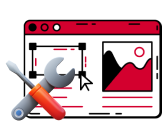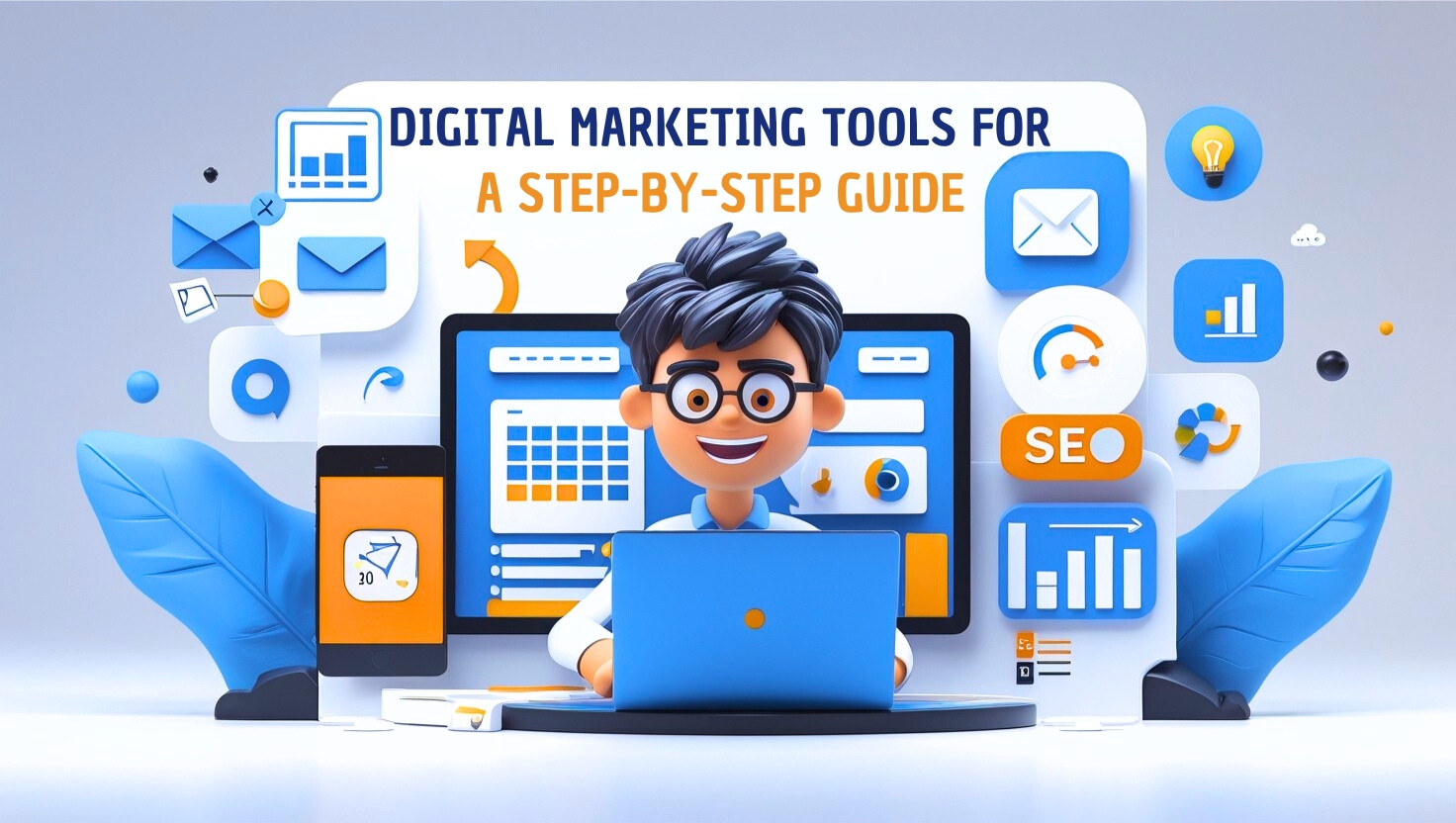Introduction: Feeling Overwhelmed? You’re Not Alone
Starting in digital marketing can feel like stepping into a room full of people all talking at once. You’ve got YouTube videos preaching content strategy, LinkedIn gurus shouting about personal branding, and blog posts dropping acronyms like CTR, ROI, and SEO like you’re supposed to know them already. If you’ve ever thought, “Where the hell do I even begin?” you’re not alone.
Here’s the truth: you don’t need a hundred tools. You need a simple roadmap, a handful of tools that work together, and a bit of confidence to hit publish, post, or send. That’s exactly what this guide will give you.
We’ll walk through the core areas of digital marketing. SEO, email, content, social media, and analytics. We’ll match each with beginner-friendly tools you can use today. Some are free, some are paid, all of them are beginner-tested and frustration-free.
No jargon. No fluff. Just the real stuff that gets results.
Step 1: Understand the Digital Marketing Landscape
Before you can build anything, you need to understand the terrain. Digital marketing is more than just posting on Instagram or writing blogs. It’s an interconnected system designed to:
- Attract visitors (SEO, ads, social media)
- Convert interest into leads (landing pages, forms)
- Nurture those leads (emails, content)
- Turn them into paying customers (offers, trust, timing)
Think of it like dating. You don’t ask someone to marry you on the first date. You build interest, show your value, stay in touch, and eventually, if you’ve done your job right, they say yes.
The right tools help you do that at scale.
Step 2: Build Your Website (Your Digital Home Base)
If you don’t have a website yet, that’s priority number one. Social media platforms are like renting space. They can change the rules or kick you out. But your website? That’s your house.
Recommended Tools:
- WordPress (with Elementor or Astra Theme). Free to start, highly customizable, and future-proof.
- Carrd. For one-page websites or landing pages. Fast, clean, and under 1 hour to launch.
- Wix or Squarespace. Drag-and-drop options with templates. Not as flexible, but beginner-safe.
Pro Tip: Don’t obsess over perfect design. Just get something live. A simple headline, your photo or logo, and what you offer is enough to start.
Step 3: Learn the Basics of SEO
Search Engine Optimization (SEO) is how you help Google understand what your site’s about and how to get free traffic over time. If SEO feels intimidating, start with the essentials:
Recommended Tools:
- Google Search Console. Tracks how your site appears in search. Free and essential.
- Ubersuggest (Free Plan). Do keyword research and see what people are searching for.
- Yoast SEO or Rank Math (WordPress plugins). Help you optimize blog posts with no tech knowledge.
SEO Tasks You Should Start With:
- Pick a target keyword for each blog or page
- Write simple, clear titles and meta descriptions
- Internally link your content (connect related posts)
- Use H1, H2, H3 headers to organize text
It’s not about gaming the system. It’s about creating helpful content and making it easy to find.
Step 4: Create and Share Valuable Content
Content is the heartbeat of digital marketing. It builds trust, educates, entertains, and keeps people coming back. But you don’t need to write 2,000-word articles every day.
Tools to Make It Easier:
- Canva. Design blog images, Instagram posts, PDFs, and more with drag-and-drop ease.
- Grammarly. Catch grammar issues, clarity mistakes, and polish your tone.
- Notion. Plan your content calendar, brainstorm ideas, and draft posts.
Types of Content to Start With:
- How-to blog posts (like this one!)
- Instagram carousels or reels
- Short how-to videos
- Lead magnets (PDF checklists, guides, templates)
Pro Tip: Focus on one platform and get good at it. Don’t try to do YouTube, Instagram, LinkedIn, and blogging all at once.
Step 5: Email Marketing Made Simple
Email might feel old school, but it works. Unlike social media, you own your email list. No algorithm can block your reach. It’s personal, direct, and incredibly powerful when done right.
Recommended Tools:
- Mailchimp (Free Plan). Send up to 500 contacts per month. Great drag-and-drop builder.
- MailerLite. Clean design, simple automations, and easy to learn. Free plan available.
- ConvertKit (Freemium). Built for creators. Strong tagging system, decent free tier.
What to Send:
- Welcome emails are sent when someone subscribes
- Weekly or bi-weekly newsletters
- Special offers or lead magnets
- Story-based emails that build a connection
Pro Tip: Write like a friend. Be useful, not salesy. Don’t stress about perfection. Just show up consistently. Your email list is your digital handshake. Treat it with care.
Step 6: Social Media Planning Without the Chaos
You don’t need to post 5 times a day to win on social. What you need is consistency, clarity, and content with purpose. That’s where scheduling tools come in. They save your time, help you plan, and take away the stress of last-minute posting.
Tools to Schedule Like a Pro:
- Buffer (Free Plan). Schedule up to 10 posts per channel. Clean, reliable, and beginner-friendly.
- Metricool (Free + Paid). Plan, post, and track content across multiple platforms. Includes analytics.
- Later or Planoly. Visual planners are designed for Instagram-first strategies.
Social Media Tips for Beginners:
- Pick one or two platforms where your audience spends time
- Create your content in batches, maybe once or twice a month
- Reuse and repurpose your posts across platforms
- Use templates to save time and effort
Pro Tip: Don’t chase viral moments. Focus on being helpful. If even a few people see your content and find it useful, you’re building real trust.
Step 7: Start Simple with Marketing Automation
Marketing automation sounds fancy, but it’s really about making your life easier. It’s how you stay consistent without burning out. Automate the boring stuff, so you can focus on the fun, creative parts of your business.
Tools to Explore:
- Zapier. Automate tasks between apps. For example, send a welcome email when someone fills out a form.
- Mailchimp Automations. Set up a simple series of emails for new subscribers.
- ConvertKit Automations. Trigger follow-ups based on subscriber behavior, like clicks or downloads.
Easy Automations to Start With:
- A welcome email that’s sent automatically
- Social posts triggered by blog publishing
- Adding leads to a Google Sheet or CRM
Pro Tip: Start with just one automation. Watch it run. Then add another. Pretty soon, your marketing will feel less like juggling and more like a rhythm you can count on.
Step 8: Tracking What Works (Analytics Tools)
You can’t improve what you don’t measure. That’s where analytics comes in. It shows you what’s working, what’s not, and where your energy is best spent. For beginners, this isn’t about crunching numbers is it’s about clarity. Imagine pouring water into a leaky bucket. No matter how much effort you put in, if you don’t know where the leaks are, you’ll stay stuck. The same goes for your digital marketing.
Recommended Tools:
- Google Analytics 4 (GA4) – Tracks who’s visiting your site, how they got there, and what they’re doing. It might look overwhelming at first, but focus on these 3 sections: Traffic Acquisition (how they found you), Engagement (what they clicked), and Conversions (did they take action?).
- Google Search Console – Tells you which keywords are bringing traffic, what pages are ranking, and where you're missing opportunities.
- Metricool or Buffer Analytics – For social content, these give you post-level insights like reach, engagement rate, and click-throughs.
What to Track First:
- Which channels are bringing the most traffic?
- What pages are converting visitors into leads?
- Which content gets shared or clicked the most?
Pro Tip: Set a 30-minute routine every Friday. Review your top traffic sources, your best-performing content, and what fell flat. Use this to guide what you do next week. Small tweaks from smart insights, that’s where the real growth lives.
Step 9: Staying Consistent and Motivated (Mindset + Habit Tools)
Let’s get real for a second: tools alone won’t build your business. Consistency will. And staying consistent is hard. You’ll hit walls. You’ll question yourself. Some days, writing that blog post or filming that reel will feel like climbing Everest in flip-flops. But here’s the thing is consistency beats intensity in the long run.
Most beginners drop off not because they lack tools or talent, but because they lose motivation, get overwhelmed, or feel like no one’s watching. That’s where a few unconventional tools (and some mindset shifts) come into play.
Helpful Stats:
- According to HubSpot, marketers who prioritize blogging are 13x more likely to see positive ROI.
- Buffer reports that 60% of marketers create at least one piece of content each day is not because they’re machines, but because they follow routines.
- Atomic Habits by James Clear found that small habits done daily outperform sporadic bursts of effort by a landslide.
Digital Tools to Keep You Consistent:
- Notion Habit Tracker Template – Track your daily marketing habits: 1 post, 10 mins of learning, 1 email draft, etc.
- Streaks App / Done App – Great for mobile users who want simple habit tracking on the go.
- Google Calendar – Block 30 mins daily for focused marketing work. If it’s on the calendar, it’s real.
Mindset Tools That Work:
- Momentum Chrome Extension – A beautiful dashboard that replaces your blank tab with a daily focus, inspiration, and goal.
- Focusmate – A virtual coworking app where you work alongside someone via video to stay accountable. Surprisingly powerful for solo marketers.
Real Talk: It’s Not About Motivation, It’s About Systems
Motivation is unreliable. But systems? Systems show up even when you’re tired. That’s the secret sauce is making your daily marketing work a habit, not a heroic act.
Pro Tip: Create a non-negotiable 30-minute marketing ritual each morning. Maybe it’s outlining a blog post, scheduling your next post, or learning something new. Over time, that ritual becomes your superpower.
Step 10: Putting It All Together – Your Beginner Marketing Stack (Real-Life Combos That Work)
By now, you've seen a lot of tools. Maybe even too many. You're probably thinking, “Okay, cool, but which ones do I need? How do I put them all together without feeling like I need a second brain or a team of ten?”
You’re not alone. Most beginners feel this, like they’re assembling IKEA furniture with no instructions and five extra bolts left over.
That’s why in this section, we’ll map out 3 simple, beginner-friendly “stacks” — tool combinations based on your current goals. Think of these like starter kits. You can always expand later, but this will get you rolling with momentum, not overwhelm.
Stack 1: “I Just Want to Start Blogging & Build an Audience”
Use this if: You're a solopreneur, writer, or freelancer who wants to get discovered via SEO and start building an email list.
Recommended Stack:
- Website Builder: WordPress + Astra + Yoast SEO
- Content Creation: Grammarly + Canva + Notion
- SEO: Ubersuggest (Free Plan) + Google Search Console
- Email Marketing: MailerLite (Free Plan)
- Tracking: Google Analytics 4
Viewer's Take:
“I used to spend hours wondering if anyone was even reading my blog. Once I plugged in Google Search Console and started seeing clicks and keyword data, it felt like someone finally turned the lights on. It’s addictive — in the best way.”
Stack 2: “I Want to Grow on Social Media & Stay Consistent”
Use this if: You’re a creator or business owner who wants to build visibility on Instagram, LinkedIn, or Twitter.
Recommended Stack:
- Content Planning: Notion Content Calendar Template
- Design: Canva
- Scheduling: Buffer (Free Plan) or Metricool
- Analytics: Built-in platform insights or Buffer Analytics
- Consistency Tools: Streaks App or Google Calendar block
Viewer's Take:
“The minute I started scheduling posts weekly instead of daily scrambling, I doubled my engagement. No more guilt when I missed a post. I actually had breathing space — and ideas flowed better.”
Stack 3: “I’m Building a Brand + Selling Something Online”
Use this if: You’re starting an e-commerce store, offering digital products, or running a service business.
Recommended Stack:
- Website Builder: Wix, Shopify, or WordPress
- SEO + Research: Ubersuggest + Google Keyword Planner
- Email Marketing: ConvertKit or Mailchimp (Free Tier)
- Automation: Zapier + welcome email sequences
- Analytics & Growth: Google Analytics + Google Search Console
Viewer's Take:
“Honestly, setting up ConvertKit felt intimidating at first, but once I had my first subscriber go through an automated welcome series, it was like magic. That system sold my first product without me touching a thing.”
Tool Stacks
Don't let all the options trick you into thinking you need everything. Most beginners thrive with just 5–7 core tools, used well. Keep it lean. Build trust. And remember — the best stack is the one you’ll use consistently.
Pro Tip: Bookmark this guide. When you're ready to upgrade, revisit your stack, not your stress level.
Step 11: What Comes After the First 90 Days
So, you've launched your site. You’ve published some content. Maybe a post got shared. Maybe someone replied to your email. Heck, maybe you’ve even seen your name show up in Google Search Console. That rush? That’s momentum.
But here’s the question most beginners get stuck on next:
“Now what?”
Because digital marketing isn’t a sprint is it’s a slow burn. A long game. And what you do after the first 90 days matters just as much as the setup. This is where you start laying the foundation for serious growth.
Evolve From Experimenting to Strategizing
In the early days, you’re testing tools and platforms. But once you’ve figured out what works for your audience and workflow, it’s time to get strategic:
- Start creating around your most popular content (look at GA4 + GSC)
- Repurpose top content into reels, emails, and carousel posts
- Build lead magnets that turn casual readers into email subscribers
- Segment your audience and tailor your messaging
Remember, you’re not just building a content machine is you’re building relationships. The more value you give, the stronger those bonds become.
Track the Right Stuff (And Ignore the Vanity Metrics)
We’ve all done it is refreshing the Instagram post 5 minutes after publishing to see if it got “likes.” But at this stage, it’s time to shift your focus to real metrics that drive results:
- Are more people signing up for your email list?
- Is your organic traffic improving month-over-month?
- Which blog topics bring in actual traffic or leads?
- How long are people staying on your site?
This data helps you make smarter decisions, not just guess and hope.
Real-World Fact:
According to a 2024 SEMrush report, marketers who use consistent performance tracking improve ROI by up to 67%. Yet only 48% of small businesses track digital metrics regularly.
That gap? That’s your opportunity.
Set a 90-Day “Growth Plan”
Don’t just float. Build a structure around your next phase. Use a simple framework:
- Goal: e.g., Grow blog traffic by 25%, get 100 email subscribers, or publish 2x per week
- Tools to Support That Goal: e.g., Ubersuggest + Notion calendar + Buffer + ConvertKit
- Weekly Actions: e.g., 1 blog, 3 social posts, 1 email, 15 mins of analytics
- Review & Adjust: Friday reflections — what’s working, what’s not
Pro Tip: Marketing success doesn’t come from “doing more.” It comes from doing the right things consistently and being kind to yourself when life happens.
Step 12: Don’t Just Use Tools is Build Systems That Scale With You
If you've made it this far, you’ve probably realized that tools are just the beginning. The real win? Building systems that keep working when you're not watching. Systems that support your ideas, automate the boring stuff, and give you the space to create, connect, and grow.
Because let’s be honest is you didn’t start this journey to spend your days logging into 12 dashboards and updating spreadsheets. You started it to build something meaningful. Something that earns attention, trust, and eventually, income.
What “Systems” Actually Look Like (Even for Beginners):
- Content Repurposing Loop
Write one blog → Turn it into 5 social posts → Use it in your newsletter → Record a short video.
(Tool combo: Notion + Canva + Buffer + ConvertKit) - Lead Generation System
Blog post with free guide → Lead magnet form → Welcome email series
(Tool combo: WordPress + MailerLite/ConvertKit + Zapier) - Weekly Marketing Workflow
Monday: Write
Tuesday: Design & Schedule
Wednesday: Analyze
Thursday: Engage & Reply
Friday: Reflect
(Tool combo: Trello or ClickUp + Calendar block)
It’s not about being everywhere. It’s about being smart with where you are and what you do there.
Data Snapshot: Why Systems Win Over Hustle
- According to CoSchedule, marketers with documented workflows are 466% more likely to report success than those without.
- A 2025 Zapier survey found that 67% of solopreneurs save at least 3 hours per week using simple automation is the equivalent of 150+ hours per year.
- Buffer's latest report shows that creators using scheduling tools and automation are 2x more consistent than those manually posting.
Let that sink in. A few systems today can buy you back a full month’s worth of time this year. Time you can spend creating, resting, or growing your business.
Your Turn: Start Small, Think Long-Term
Pick just one system to build this week.
Don’t aim for complex. Aim for repeatability.
Whether it’s a weekly email, a blog-to-social pipeline, or a checklist before publishing, systems compound, they free up your headspace and let you focus on the stuff that matters: building relationships, delivering value, and staying inspired.
Pro Tip: Every time you do something more than once, ask: “Can I systemize this?” If yes, you’re scaling.
One Last Thing: You Deserve to Show Up
Let’s drop the marketing talk for a second. This part isn’t about tools or traffic. It’s about you.
You clicked on this guide because you're building something is a business, a brand, a voice. That takes guts. Most people never start. You're already ahead.
But maybe you've had days when you second-guess every word.
Maybe you’ve seen others with slick websites and viral content and wondered,
“What if I’m not cut out for this?”
Let me tell you something: You are.
Digital marketing isn’t a talent contest. It’s not about having the perfect niche or sounding like everyone else. It’s about showing up consistently, imperfectly, and truthfully.
You don’t need to be an expert.
You don’t need to go viral.
You just need to begin is and keep going.
One blog post.
One email.
One helpful piece of content at a time.
Because someone out there is searching for the exact thing you have to offer, maybe it’s a solution. Maybe it’s hope. Maybe it’s just the feeling of “Hey, I’m not alone.”
And your presence online is no matter how small it feels right now, can be that light for someone else.
So when you feel discouraged, come back to this:
- You don’t need to do everything. Just the next right thing.
- You don’t need to be perfect. Just present.
- You don’t need a huge following. Just a clear purpose.
Marketing isn’t just selling, it’s serving. It’s human. And so are you.
So show up. Keep building.
The algorithms may shift. The tools will evolve. But your voice is the constant.
And it’s worth sharing.
You’re Not Behind is You’re Just Getting Started (And That’s Enough)
Let’s pause for a second. Just you and me is no fancy tools, no dashboards, no noise.
If you’ve made it to this point in the guide, it means something. You’re not a passive scroller or someone looking for quick-fix marketing magic. You’re a builder. A beginner, maybe, but also a doer. And that deserves to be acknowledged.
Because getting into digital marketing isn’t easy.
There’s a tidal wave of content online telling you to “crush your funnel,” “10x your growth,” or “dominate your niche”, all before you’ve even figured out how to write your first post or send a welcome email.
And honestly? That stuff can make you feel like you’re already behind before you’ve even begun.
But here’s the truth, most of those guru-style blogs won’t tell you:
You’re not late. You’re not behind. And you don’t need to know everything right now.
The only thing you need? The willingness to keep showing up.
That’s it.
Not 20 digital marketing tools. Not a flawless strategy.
Just the decision to try is even when it’s clumsy, even when no one is watching yet.
Showing Up > Showing Off.
There’s a weird pressure in digital spaces to make everything look polished and professional, like we’re all running Fortune 500 brands out of our bedrooms. But perfection is a lie. And it’s also boring.
What people respond to is honesty. Realness. Heart.
A blog post written in your voice with typos and all will connect more than the most “optimized” article if it feels like someone’s talking to them.
An Instagram post that shares something you’ve actually learned will land harder than a Canva template with 37 hashtags.
So don’t try to “market” like someone else.
Market like you talk. Market like you care. Market like someone’s listening, because someone is.
The Quiet Power of Doing It Anyway
Some days, you’ll write a post that gets 3 views.
Some weeks, your emails won’t get a single reply.
You’ll schedule something and doubt it before it even goes live.
That’s part of it.
Everyone you admire started there, too. The only difference between them and you is time and how many times they were willing to try again.
What matters most isn’t your following or your funnel.
You can keep creating through the quiet.
Because digital marketing is the kind that lasts, it isn’t built on hype.
It’s built on consistency, curiosity, and a willingness to keep figuring it out.
Permit Yourself to Be New
You don’t need to be an expert yet. You shouldn’t be.
Beginners ask better questions.
Beginners experiment more.
Beginners, pay attention.
So don’t rush through this phase. Let it shape you. Let it teach you. This is where you find your voice. This is where you build the habits that turn into systems. This is where you make mistakes that give you real wisdom.
Every blog, every post, every email is it all adds up.
The work you’re doing right now is laying bricks for something real.
Maybe it’s a small business. Maybe it’s a personal brand. Maybe it’s a life you control instead of one you tolerate.
Whatever you’re building, this guide, this moment, it’s just the beginning.
So take a breath.
Revisit one section. Pick one tool. Send one email. Publish one thing.
That’s how it starts.
That’s how it grows.
That’s how you win - quietly, consistently, and completely on your terms.
You’ve got this for real.
Final Thoughts: You Don’t Need to Know Everything, You Just Need to Start
Let’s be honest. Digital marketing can feel like trying to drink from a firehose. One minute you’re figuring out what SEO means, and the next someone’s telling you to build an email funnel, batch content, schedule reels, track KPIs, and somehow “engage with your audience authentically” while doing it.
It’s a lot.
But you don’t need to master it all today. You just need to start. And you already have, by reading this guide, asking smart questions, and exploring the tools that fit your goals, not someone else’s highlight reel.
Here’s what I’ve learned (after years of testing tools, launching campaigns, failing a bunch, and getting back up):
- The most successful marketers aren’t the smartest, they’re the most consistent.
- The best tools are the ones you’ll use, not the ones with the fanciest dashboards.
- You don’t need to be on every platform. You need to show up where your audience is, and show up well.
- Confidence comes from momentum, not magic. Action creates clarity. Not the other way around.
So permit yourself to take it slow. Messy action is better than no action. That first blog post might feel awkward. Your first email might get only five opens. Your first social post might get ignored.
Do it anyway.
Because over time, something wild happens:
You find your voice.
You understand your audience.
You get sharper.
And then one day… You realize, “Wait, am I doing it. I’m doing it.”
And that feeling? That’s why we’re here.
What You Should Do Now
- Set a weekly marketing ritual, even just 30 minutes
- Bookmark this guide and revisit it when you feel stuck
- Sign up for the Internet Keeda Blog for real advice, not recycled fluff
- Try one new tool this week, and let it work for you
You’re not alone in this. Every creator, business owner, or marketer you admire started with a blank page and a little courage.
Now it’s your turn.
You’ve got the tools.
You’ve got the vision.
And now?
You’ve got the roadmap, too.
Let’s go build your digital marketing journey is one step, one tool, one win at a time.
 Bundles
Bundles Flash Sales
Flash Sales






















Comments (0)